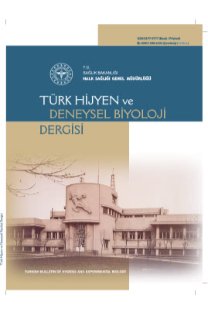Comparison of conventional and rapid methods for determination of total aerobic mesophilic microorganisms and Enterobacteriaceae in poultry products
Kanatlı eti ürünlerinde toplam aerobik mezofilik mikroorganizma ve Enterobacteriaceae belirlenmesinde klasik ve hızlı yöntemlerin karşılaştırması
___
- 1. Yücel Baydur A. İstanbul’da satışa sunulan tavuk etlerinin hijyenik kalitesi üzerine araştırmalar. Yüksek Lisans Tezi, İstanbul Üniversitesi, Besin Hijyeni ve Teknolojisi Bölümü, 2006.
- 2. İşeri Ö, Erol İ. Hindi etinden kaynaklanan başlıca bakteriyel infeksiyon ve intoksikasyonlar. Ankara Üniv Vet Fak Derg, 2009; 56: 47-54.
- 3. Sezen AG. Piyasada satışa sunulan taze kanatlı et preparatlarının son kullanma tarihlerinde duyusal ve mikrobiyolojik kaliteleri. Doktora Tezi, İstanbul Üniversitesi, Sağlık Bilimleri Enstitüsü, 2007.
- 4. Montville TJ, Matthews KR. Food microbiology: an introduction. Washington DC: ASM Press, 2008.
- 5. Halkman HBD, Halkman AK. Indicator organisms. In: Batt CA, Tortorello ML, eds. Encyclopedia of Food Microbiology. Vol 2. 2nd ed. London: Elsevier Ltd, Academic Press, 2014: 358-63.
- 6. Owen M, Willis C. Lamph D. Evaluation of the TEMPO most probable number technique for the enumeration of Enterobacteriaceae in food and dairy products. J Appl Microbiol, 2010; 109, 1810-6.
- 7. Torlak E. Gıda mikrobiyolojisinde Enterobacteriaceae üyeleri için kromojenik ve florojenik besiyerleri. Türk Hij Den Biyol Derg, 2011; 68 (1): 49-58.
- 8. Lakicevic E, Velebit B, Borovic B, Janković V, Spirić D, Matekalo-Sverak V, et al. TEMPO® most probable number technique for the enumeration yeasts and molds in feed and food products. Biotechnology in Animal Husbandry, 2011; 27(3): 1329-35.
- 9. Anonymous. TEMPO EB Test Procedure, https:// techlib.biomerieux.com/wcm/techlib/techlib/ storyboard/welcome/welcome.jsp, Accessed: 03.05.2012.
- 10. Anonymous. ISO 4833:2003 - Microbiology of food and animal feeding stuffs – horizontal method for the enumeration of microorganisms - Colonycount technique at 30 °C. Geneva: International Standardization for Organization, 2003.
- 11. Anonymous. TEMPO TVC (Total Viable Count) Ref 80 007. bio-Me´rieux, Marcy-l’Etoile, France, 2009.
- 12. Anonymous. ISO 21528-2:2004 - Microbiology of food and animal feeding stuffs – Horizontal methods for the detection and enumeration of Enterobacteriaceae - Part 2: Colony-count method. Geneva: International Standardization for Organization, 2004.
- 13. Anonymous. TEMPO EB (Enterobacteriaceae), Ref 80003. Bio-Me´rieux, Marcy-l’Etoile, France, 2010.
- 14. Altınışık M. http://www.mustafaaltinisik.org. uk/45-uzm-09.pdf, Accessed: 03.05.2012.
- 15. Line JE, Stern NJ, Oakley BB, Seal BS. Comparison of an automated most-probable-number technique with traditional plating methods for estimating populations of total aerobes, coliforms, and Escherichia coli associated with freshly processed broiler chickens. J Food Protec, 2011; 74 (9): 1558- 63.
- 16. Paulsen P, Schopf E, Smulders FJM. Enumeration of total aerobic bacteria and Escherichia coli in minced meat and on carcass surface samples with an automated most-probable-number method compared with colony count protocols. J Food Protect, 2006; 69 (10): 2500-3.
- 17. Mahler C, Stolle A. Automated cell count via Tempo® system for more efficient routine examinations in food microbiology laboratories. Fleischwirtschaft, 2006; 86 (6): 98-100.
- 18. Paulsen P, Schopf E, Fuga L, Smulders FJM. Enumeration of Enterobacteriaceae in food stuffs: effect of incubation temperatures of 30 °C as compared to 35/37 °C. Arc Lebensmittel Hyg, 2008; 59: 192-6.
- 19. Katase M, Tsumura K. Enumeration of microorganisms in processed soy products with an automated most probable number method compared with standard plate method. Lett Appl Microbiol, 2011; 53: 539-45.
- 20. Paulsen P, Borgetti C, Schopf E, Smulders FJM. Enumeration of Enterobacteriaceae in various foods with a new automated most-probable-number method compared with petrifilm and International Organization for Standardization Procedures. J Food Protect, 2008; 71 (2): 376-9.
- ISSN: 0377-9777
- Yayın Aralığı: 4
- Başlangıç: 1938
- Yayıncı: Türkiye Halk Sağlığı Kurumu
Kurşun maruziyetinin taranmasında saç ve idrar numunelerinin kullanılabilirliğinin araştırılması
Müjgan ERCAN, Fatma Meriç YILMAZ, Oya TORUN-GÜNGÖR, Engin TUTKUN, Murat BÜYÜKŞEKERCI, Ceylan BAL
Dilek KANYILMAZ, Yakup GÜRKAN, İpek MUMCUOĞLU, Yasemin GENÇ, Altan AKSOY, Neriman AKSU
Zararlılarla mücadele adı altında semt pazarlarında satılan ürünlerin aktif içeriğinin incelenmesi
Perihan Binnur KURT-KARAKUŞ, Kadir GEDIK, Emine CAN-GÜVEN, Banu OĞUZ, Ahmet ÇIL, Deniz TEZCAN
Alignment of new bathing water EU directive and its applications to protect public health
Vorikonazol ile tedavi edilen bir Aspergillus flavus kompleks keratit olgusu
Özlem Evren KEMER, Gülşen HAZIROLAN, Dilay ÖZEK, Altan AKSOY, Neriman AKSU
Rüştü TAŞTAN, Levent ALTINTAŞ, Sibel CEVİZCİ
Nedim ÇAKIR, meryem güvenir, Umut GAZİ, Emrah RUH, Kaya SÜER
Farklı biyolojik organizmalarda proteomik uygulamalar
Hatice YILDIZHAN, Demet CANSARAN-DUMAN, Sinem ÖZENOĞLU, Duygu ÖZEL-DEMİRALP
Kırmızı biberde aflatoksin oluşturmayan Aspergillus flavus izolatlarının belirlenmesi
Mehmet KOÇ, Bekir Bülent ARPACI, Kerim KARATAŞ, Peter J. COTTY, Ayhan AK
